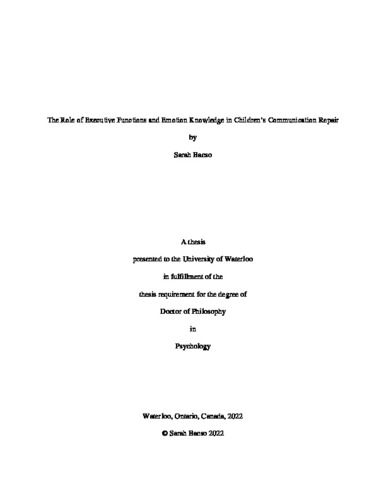| dc.description.abstract | Young children often provide insufficient information when speaking with others, making the ability to identify miscommunications and repair inadequate messages essential skills within their set of communicative abilities. Previous work has investigated children’s ability to detect and repair miscommunications in response to verbal cues from their listeners, but no work has explored their ability to do so in response to nonverbal cues from a listener. Study 1 assessed children’s ability to detect and repair miscommunications in response to nonverbal cues provided by a listener. Children (ages 4 to 6) provided a virtual child listener with instructions on how to find a prize. If the child provided a uniquely identifying message, the listener looked happy after presumably finding the prize. If the child provided an ambiguous message, the listener appeared sad after presumably failing to find the prize. Children demonstrated awareness, through ratings, as to whether or not the listener found the prize on each trial, based solely on her facial expression. Children were also more likely to attempt to repair their messages on trials where the listener appeared sad. With respect to individual differences, children with stronger executive functioning (as indexed by a latent variable) and emotion knowledge were more accurate in their ratings of communicative success. Children with stronger emotion knowledge were also more likely to attempt to repair their messages when the listener appeared sad. Overall, findings from Study 1 suggest that children are able to make use of nonverbal cues from a listener to detect and repair miscommunications. Findings also suggest that executive functioning and emotion knowledge support children’s ability to detect and repair miscommunications. Study 2 compared children’s ability to detect miscommunications and immediately repair their messages in response to different types of listener feedback. That is, children were provided with an opportunity to respond directly following the listener’s affective response (rather than after questions) and prior to the listener’s selection of prize location. After providing an ambiguous message, children (ages 4 to 6) were provided with feedback indicating the listener was confused. Children were more likely to attempt to repair their messages following verbal cues from the listener compared to a baseline condition (i.e., a listener pause). Notably, nonverbal feedback (i.e., a confused facial expression) was no better than the baseline condition at eliciting communication repair. The combination of verbal and nonverbal cues was also no more effective at eliciting communication repair than verbal cues alone. Interestingly, children frequently attempted to repair their messages in the baseline condition, which consisted only of a listener pause. When executive functioning components were examined individually, working memory was found to be associated with children’s likelihood of attempting to repair their messages, and with the quality of children’s repairs. Emotion knowledge was found to be associated with the quality of children’s repairs. The findings of Study 2 suggest that children are able to repair their messages in response to nonverbal feedback (given that they attempted to repair even in the baseline condition), but that they are more likely to repair their messages in response to verbal feedback. Findings also highlight the important role of executive functioning and emotion knowledge in children’s communication. Results from these two studies have theoretical implications for children’s communicative development, as well as implications for research methodology, the measurement of executive functioning, and interventions targeted to improve children’s communication skills. | en |

